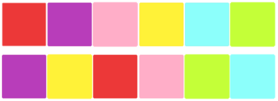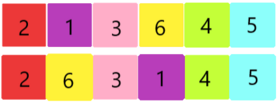CF1677C.Tokitsukaze and Two Colorful Tapes
普及/提高-
通过率:0%
AC君温馨提醒
该题目为【codeforces】题库的题目,您提交的代码将被提交至codeforces进行远程评测,并由ACGO抓取测评结果后进行展示。由于远程测评的测评机由其他平台提供,我们无法保证该服务的稳定性,若提交后无反应,请等待一段时间后再进行重试。
题目描述
Tokitsukaze has two colorful tapes. There are n distinct colors, numbered 1 through n , and each color appears exactly once on each of the two tapes. Denote the color of the i -th position of the first tape as cai , and the color of the i -th position of the second tape as cbi .
Now Tokitsukaze wants to select each color an integer value from 1 to n , distinct for all the colors. After that she will put down the color values in each colored position on the tapes. Denote the number of the i -th position of the first tape as numai , and the number of the i -th position of the second tape as numbi .
 For example, for the above picture, assuming that the color red has value x ( 1≤x≤n ), it appears at the 1 -st position of the first tape and the 3 -rd position of the second tape, so numa1=numb3=x .
For example, for the above picture, assuming that the color red has value x ( 1≤x≤n ), it appears at the 1 -st position of the first tape and the 3 -rd position of the second tape, so numa1=numb3=x .
Note that each color i from 1 to n should have a distinct value, and the same color which appears in both tapes has the same value.
After labeling each color, the beauty of the two tapes is calculated as $$$$\sum_{i=1}^{n}|numa_i-numb_i|. $$$$
Please help Tokitsukaze to find the highest possible beauty.
输入格式
The first contains a single positive integer t ( 1≤t≤104 ) — the number of test cases.
For each test case, the first line contains a single integer n ( 1≤n≤105 ) — the number of colors.
The second line contains n integers ca1,ca2,…,can ( 1≤cai≤n ) — the color of each position of the first tape. It is guaranteed that ca is a permutation.
The third line contains n integers cb1,cb2,…,cbn ( 1≤cbi≤n ) — the color of each position of the second tape. It is guaranteed that cb is a permutation.
It is guaranteed that the sum of n over all test cases does not exceed 2⋅105 .
输出格式
For each test case, print a single integer — the highest possible beauty.
输入输出样例
输入#1
3 6 1 5 4 3 2 6 5 3 1 4 6 2 6 3 5 4 6 2 1 3 6 4 5 2 1 1 1 1
输出#1
18 10 0
说明/提示
An optimal solution for the first test case is shown in the following figure:
 The beauty is ∣4−3∣+∣3−5∣+∣2−4∣+∣5−2∣+∣1−6∣+∣6−1∣=18 .
The beauty is ∣4−3∣+∣3−5∣+∣2−4∣+∣5−2∣+∣1−6∣+∣6−1∣=18 .
An optimal solution for the second test case is shown in the following figure:
 The beauty is ∣2−2∣+∣1−6∣+∣3−3∣+∣6−1∣+∣4−4∣+∣5−5∣=10 .
The beauty is ∣2−2∣+∣1−6∣+∣3−3∣+∣6−1∣+∣4−4∣+∣5−5∣=10 .